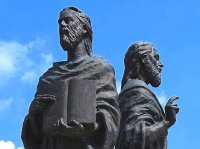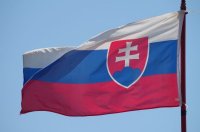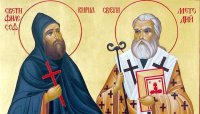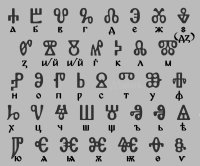 The commemoration of the arrival of St. Cyril and Methodius in Moravia is not only about church life. Their purpose is to tell about the cultural and educational significance of the work of the Solunsk brothers.
The commemoration of the arrival of St. Cyril and Methodius in Moravia is not only about church life. Their purpose is to tell about the cultural and educational significance of the work of the Solunsk brothers.
Cyril and Methodius are canonized and honored in both the east and west of Christian world.
Cyril and Methodius
The brothers were born in the city of Solun (now Thessaloniki). Methodius was born in 815, the younger brother was born twelve years later. At birth he received the name Constantine. He did not become Cyril until after his tonsure as a monk, shortly before his death. He did become Cyril only after his tonsure as a monk, shortly before his death.
The brothers came from a good family - their father was an officer in the Byzantine army. It is impossible to establish the ethnicity of Cyril and Methodius.
Solun, like the rest of Byzantium, was a multinational empire. However, a number of indirect signs indicate that they were of Greek origin. However, many historians in various Slavic countries have tried to prove that the brothers belonged to the Solunian Slavs.
Both brothers received an excellent education, but their lives were different for a long time. Methodius succeeded in military service, but then became a monk and abbot of a monastery on Mount Lesser Olympus (present-day Uludag in Turkey). Cyril was fascinated from an early age by the study of ecclesiastical works and eventually became involved in teaching and missionary work.
At the end of the 850s the brothers formed around themselves a circle of like-minded people that formed at the monastery, which was ruled by Methodius. In 860 the brothers took part in the famous "Khazar mission". In the course of it Cyril tried to convince the Khazar Khagan to embrace the Christian faith in a dispute with a rabbi and a Jew. The mission ended with the Kagan refusing to convert, and Cyril and Methodius returned to Byzantium, from where they went almost immediately to Moravia.
The brothers developed the first ever Slavonic alphabet, the Glagolitic alphabet, for the purposes of their mission. Its main author was Cyril who took graphemes from the old Greek script and eastern alphabets as a basis. Glagolitsa's main difference was the greater number of letters which were to more precisely reflect phonetics of the language. It was the wish to create such alphabet that made the enlightener start working on a new alphabet.
The original Moravian variant of the glagolitic alphabet consisted of 38 graphemes. Glagolitic characters also represented numbers, so it was possible to compose not only words, but numbers as well.
The eighth character of the alphabet denotes the sound [dz], which in the middle of the ninth century was used only on the territory of modern Slovakia. Source: Wikipedia. Glagolitic was not widespread and was almost completely overshadowed by the other Slavic alphabet - Cyrillic. The only Slavic nation which didn't reject glagolitsa were Croats - they kept using it till XIX century. Nevertheless, Kirill's work was of great importance for the development of Slavic culture. During the work on glagolitsa the first Slavic literary language known today as Old Slavic was created. It was based on the old Macedonian language, which at that time was spoken by the Slavs living in Solun. With the help of the new alphabet Cyril and Methodius managed to make the first translations of Greek religious texts into Slavic.
The Velikomoravskoan School
The main task of Cyril and Methodius mission was enlightenment work. It was conducted in the Velikomoravskoy school, which was founded by Priest Rastislav in 863. There the brothers educated future priests and administrative workers. The school existed for more than 20 years, and during this time at least 200 people graduated from it.
For a long time the location of the school remained unknown. It was not until the late 1980s that it was proven to have been on Devin Castle. Its traces were discovered 60 years earlier by the Czech archaeologist Inokent Červinka.
The mission of the brothers lasted a little more than three years. All this time they were translating church books from Greek into Slavic and teaching Moravians to read, write, and conduct worship in the Slavic language.
In 867 Cyril and Methodius were invited to Rome, where they met with the new Pope Adrian II. I,who favored the missionaries and gave them permission to use the Slavic language in their worship, which became known as the Glagolitic Rite.
According to one widespread version, it was thanks to Cyril and Methodius that the "double cross" first appeared in Moravia, an old Byzantine symbol of the resurrection of Jesus Christ, which later became one of the state symbols of Slovakia. In Byzantium it was used as a religious and political symbol, and the two cross bars symbolized the sign nailed over Christ's head before his execution, and the pole to which Jesus' feet were nailed. The double cross can be found on the coat of arms of Hungary, as well as on the "Pogonya", the old coat of arms of the Grand Duchy of Lithuania, which later migrated to Belarusian and Lithuanian heraldry.
Cyril's Death
 The trip to Rome was Cyril's last - in February 869 he became seriously ill and died. His tomb is located in the Basilica of St. Clement, not far from the Colosseum. According to tradition, before he died Cyril told his brother that he should continue his enlightenment work.
The trip to Rome was Cyril's last - in February 869 he became seriously ill and died. His tomb is located in the Basilica of St. Clement, not far from the Colosseum. According to tradition, before he died Cyril told his brother that he should continue his enlightenment work.
After his brother's death, Methodius was ordained archbishop of Moravia and Pannonia. Having gathered his disciples again, in 870 Methodius returned to Great Moravia, the situation in which by that time had drastically changed. Prince Rastislav was defeated in another battle with the Franks and died in a Bavarian prison, while his successor, Prince Sviatopolk, completely submitted to German political influence.
Having regained control of the Moravian lands, the Franks banned worship in Slavic, returning Latin to the churches. Methodius, who opposed this ban, was imprisoned in the monastery of Reichenau, located on Lake Constance in the very south of modern Germany.
The fight for the Slavic language
The new Pope John VIII came to the defense of Methodius. He banned Frankish priests from conducting liturgies until his release. However, the church leader forbade worship in the Slavic language, permitting only sermons to be conducted in it.
Methodius was released almost immediately and returned to church duties. He ignored Ioan's prohibition and continued to conduct worship in the Slavic language. Because of this, in 878 the German bishops organized a new trial against him, accusing Methodius not only of using the Slavic language, but also of misinterpreting the Gospel.
 The conflict had to be resolved again in Rome. Methodius stood in front of Ioan VIII and not only managed to prove the wrongness of the Frankish priests, but also obtained from the head of the church a special decree equalizing Great Moravia in rights with the East Frankish Empire. This was a great victory for Methodius, who again obtained the right to conduct most of the worships services in Slavic
The conflict had to be resolved again in Rome. Methodius stood in front of Ioan VIII and not only managed to prove the wrongness of the Frankish priests, but also obtained from the head of the church a special decree equalizing Great Moravia in rights with the East Frankish Empire. This was a great victory for Methodius, who again obtained the right to conduct most of the worships services in Slavic
In 882 Methodius returned to Great Moravia, where he spent the last three years of his life. During this time he together with his pupils continued to translate the Greek church books. On April 6, 885 70-years-old Methodius dies in Velehrad.
Almost nothing is known about the city of Velehrad, which was the capital of Great Moravia - it was first mentioned in the Czech chronicles only in the 13th century. Even its location remains unknown. It was in this city, according to biography, Mefodiy died and was buried. Information about this is also minimal. The "Legend of Saint Methodius" says only that he "was buried in the Moravian capital temple on the left side in the wall behind the altar of the Virgin Mary". There is a small village of the same name in southern Moravia. Every year on July 5 a national pilgrimage takes place there, but this town probably has nothing to do with the "old" Velehrad.
 Before he died, Methodius managed to appoint as his successor one of his pupils - the bishop Horazd, born in the neighborhood of Nitra, who was also to head the Great Moravian school. However almost immediately after the death of Methodius the Franks, with the consent of Prince Sviatopolk, quickly dealt with his students. Some of them were imprisoned, some were exiled from the country. Horace's fate remains unknown - according to various sources, he was either murdered or managed to hide from persecution in the territory of modern Czechia, Poland or Bulgaria.
Before he died, Methodius managed to appoint as his successor one of his pupils - the bishop Horazd, born in the neighborhood of Nitra, who was also to head the Great Moravian school. However almost immediately after the death of Methodius the Franks, with the consent of Prince Sviatopolk, quickly dealt with his students. Some of them were imprisoned, some were exiled from the country. Horace's fate remains unknown - according to various sources, he was either murdered or managed to hide from persecution in the territory of modern Czechia, Poland or Bulgaria.



